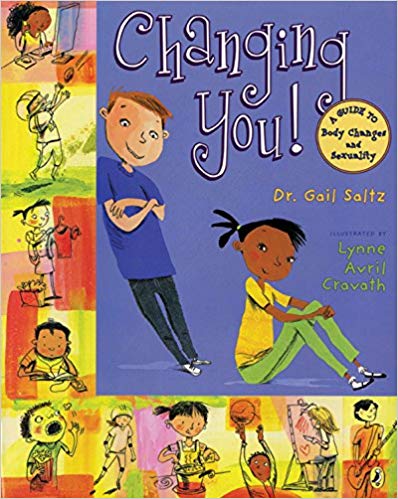Anatomy of Male Bodies
This video goes over the external and internal parts of biological male anatomy. It also defines an erection, semen, scrotum, testicles, and pre-ejaculate fluid (pre-cum). The video explains the difference between a circumsized and uncircumsized penis, how urine and semen travel through the urethra, and the inner workings of ejaculation. [AMZ-069]
Youth
Most people have the same basic body parts—heads, arms, legs and feet. While we are mostly similar, we do have different reproductive and sexual organs. A person who is male or assigned the sex of male at birth typically has a penis; a urethra, where urine and semen leave the body, a scrotum, which contains two testes; and an anus.
Just as people’s appearance can vary greatly so do people’s reproductive organs vary in the way they look. Some penises are circumcised, meaning the foreskin has been removed, and some are uncircumcised, meaning the foreskin is intact. Both are normal.
People with a penis also have a variety of internal reproductive organs, including the prostate, seminal vesicles, Cowper’s glands and epididymis. The testicles start producing sperm during puberty, and continue to create sperm until a person dies.
It is important to take care of one’s sexual health by knowing what your body is like when it’s healthy and seeking medical care if anything should change with how your body functions, looks or smells.
FAQs
Everybody goes through puberty at their own pace. Hormones—the body’s chemical signals—tell your body to begin changing. Some people who are biologically male may experience a growth spurt sooner than others, while other might get facial hair or a deeper voice later than others. Your body will go through puberty at the exact right time for you, and there’s no way to speed it up or slow it down. So don’t worry, it’s all totally normal!
Yes, during puberty, people can experience strong sexual feelings for no reason. A person that has a penis may get erections, when the penis fills with blood and stands away from the body. Erections can happen at times that are inconvenient, like while you’re sitting in class, which can be embarrassing. It’s good to have a plan for what you can do if and when this happens to you. You can try carrying an extra sweatshirt in your backpack to tie around your waist or a book you can carry in front of you. Mostly, don’t worry—it happens to everyone and as you get older, it won’t happen nearly as much.
During puberty the body produces a hormone called testosterone that tells the testicles to start making sperm. Once the body starts making sperm, semen—the fluid that contains sperm—can be released through the tip of the penis. This is called ejaculation. Wet dreams happen when ejaculation occurs spontaneously while a boy is sleeping. Often when you have that first wet dream, you may think you have peed in the bed, but it’s actually semen. You can simply take the sheet off the bed and put it in the hamper to be washed. And remember, wet dreams are normal if you have them and normal if you don’t.
Additional Resources
Parents
During puberty, a person goes through many physical, emotional and social changes. Boys usually begin puberty between the ages of 9 and 15, and it may take five to seven years for all of the changes to occur. It is important for caring adults to use the appropriate anatomical names for children’s body parts. This lays the foundation for talking about the changes of puberty before and while young people are experiencing them. It is also essential to assure young people that these changes are normal. Helping young people identify ways to cope with these changes can make this stage of life less stressful. Talking about these changes with the young people in your life lets them know that they are not alone and that they can come to their parents or guardians if they have questions or need support.
CONVERSATION STARTERS
If you start essential conversations about topics like puberty with your children, then they will know they can come to you with questions. The easiest way to start these conversations is to talk about issues as they arise in everyday life while you are doing things like watching TV together. Masturbation, wet dreams and spontaneous erections may not just come up in conversation, but it’s important to talk about the issues that can provoke anxiety or worry for boys. If you talk with your child, he will know what to expect and how to cope. Below are some ways to start these conversations:
Try broaching these topics while doing something related to them. For example, while in the store buying deodorant for yourself, you can share why you use deodorant and ask which one your child wants to try. While shaving your face, you can bring your child in to shave together. These actions can create opportunities for conversations about puberty to happen in as natural a setting as possible.
When the two of you are alone after dinner, you could say, “Boys your age or a little older sometimes ejaculate while they are sleeping. I want you to know that it’s normal if that happens to you and it’s normal if it doesn’t. If it happens, you can just throw your sheets in the hamper and put on some new ones. No worries at all. What do you think?”
Educators
During puberty, a person goes through many physical, emotional and social changes. Boys usually begin puberty between the ages of 9 and 15, and it may take five to seven years for all of the changes to occur. It is important for health educators to use the appropriate anatomical names for body parts and educate students about how the body functions. This lays the foundation for lessons that require knowledge of anatomy. Explaining the changes of puberty to young men before and while they are going through them will help reassure them that these changes are normal. Helping young people identify ways to cope with these changes can make this stage of life less stressful. Talking about these changes with the young people lets them know that they are not alone and that they can come to their parents, guardians or other trusted adults if they have questions or need support.
National Sex Education Standards
List medically accurate names for body parts, including the genitals
Recall the human reproductive systems, including the external and internal body parts and their functions, and that there are natural variations in human bodies
International Technical Guidance on Sexuality Education
Discussion Questions
What are some of the external body parts that were mentioned in the video?
What is the function of that body part?
What are some of the internal body parts that were mentioned in the video?
What is the function of that body part?
Were there any body parts or names for body parts that were new or surprising to you?
How might using the correct anatomy terms be useful to someone?




